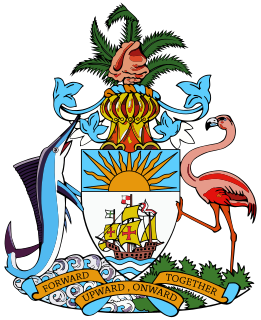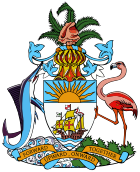
The Bahamas, known officially as the Commonwealth of The Bahamas, is a country within the Lucayan Archipelago. The archipelagic state consists of more than 700 islands, cays, and islets in the Atlantic Ocean, and is located north of Cuba and Hispaniola, northwest of the Turks and Caicos Islands, southeast of the U.S. state of Florida, and east of the Florida Keys. The capital is Nassau on the island of New Providence. The designation of "the Bahamas" can refer either to the country or to the larger island chain that it shares with the Turks and Caicos Islands. The Royal Bahamas Defence Force describes the Bahamas territory as encompassing 470,000 km2 (180,000 sq mi) of ocean space.

Grand Bahama is the northernmost of the islands of The Bahamas, lying 84 kilometres (52 mi) off Palm Beach, Florida. It is the fourth largest island in the Bahamas island chain of approximately 700 islands and 2,400 cays. The island is roughly 530 square miles (1,400 km2) in area and approximately 153 kilometres (95 mi) long west to east and 24 kilometres (15 mi) at its widest point north to south. Administratively, the island consists of the Freeport Bonded Area and the districts of East Grand Bahama and West Grand Bahama.

Elections in the Bahamas take place in the framework of a parliamentary democracy. Since independence voter turnout has been generally high in national elections, with a low of 87.9% in 1987 and a high of 98.5% in 1997. The current Prime Minister is the Hon Hubert Minnis.

General elections were held in the Bahamas on 2 May 2002. The opposition Progressive Liberal Party (PLP) won 29 of the 40 seats in the House of Assembly to defeat the governing Free National Movement (FNM). Voter turnout was 90.2%.

A multiple referendum with five questions was held in the Bahamas on 27 February 2002. Voters were asked whether they approved of:
- the removal of gender discrimination from the constitution
- the creation of a national commission to monitor the standards of teachers
- the creation of an independent parliamentary commissioner
- the creation of an independent election boundaries commission
- the increase of the retirement ages of judges from 60 to 65

General elections were held in the Bahamas on 26 November 1962, the first under universal suffrage. Whilst the Progressive Liberal Party won the most votes, the United Bahamian Party won the most seats, largely as a result of gerrymandering.

General elections were held in the Bahamas on 10 January 1967. The result was a tie between the Progressive Liberal Party and the United Bahamian Party, both of which won 18 seats. In a reversal of the last election, this time the PLP won fewer votes but was able to form the country's first black-led government with the support of the sole Labour Party MP Randol Fawkes.

Early general elections were held in the Bahamas on 10 April 1968. The result was a victory for the Progressive Liberal Party, which won 29 seats. Voter turnout was 85.5%.

General elections were held in the Bahamas on 19 July 1977. The result was a victory for the Progressive Liberal Party, which won 30 of the 38 seats. Voter turnout was 92.6%.

General elections were held in the Bahamas on 10 June 1982. The result was a victory for the Progressive Liberal Party, which won 32 of the 43 seats. Voter turnout was 89.8%.

General elections were held in the Bahamas on 19 June 1987. The result was a victory for the Progressive Liberal Party, which won 31 of the 49 seats. Voter turnout was 87.9%.

General elections were held in the Bahamas on 19 August 1992. The ruling Progressive Liberal Party won only 44.7% of the popular vote and 16 seats in the House of Assembly. The opposition Free National Movement won 55% of the popular vote and 33 of the 49 seats. Voter turnout was 91.1%.

General elections were held in the Bahamas on 14 March 1997. The result was a victory for the Free National Movement, which won 34 of the 40 seats, and through a by-election later increased this to 35. Voter turnout was 92.9%. Hubert Ingraham was sworn in for a second term as Prime Minister on 18 March.
The United Bahamian Party (UBP) was a major political party in the Bahamas in the 1950s and 1960s. Representing the interests of the white oligarchy known as the Bay Street Boys, it was the ruling party between 1958 and 1967. It was led by Roland Theodore Symonette.
The Labour Party was a minor political party in the Bahamas. In the 1962 general elections it won a single seat, taken by Randol Fawkes. Fawkes retained his seat in the 1967 elections, in which the United Bahamian Party and the Progressive Liberal Party won 18 seats each. Although the UBP had won more votes, Fawkes supported the PLP, allowing them to form a government. Fawkes retained his seat again in the 1968 elections, but the party did not contest the 1972 elections.
The Commonwealth Labour Party was a minor political party in the Bahamas. It contested the 1972 general elections, in which it received only 254 votes and failed to win a seat.
The Bahamian Democratic Party was a political party in the Bahamas. It contested the 1977 general elections, in which it received 26.9% of the votes and won six seats, becoming the largest opposition party in Parliament. However, it did not run in the 1982 elections.
The Workers' Party was a minor political party in the Bahamas. It contested the 1982 elections, in which it received only 31 votes and failed to win a seat.
The Commonwealth Democratic Party was a minor political party in the Bahamas. It contested the 1982 elections, in which it received only 13 votes and failed to win a seat.
Sir Cyril Stanley Smith Fountain is a Bahamian judge and lawyer.




